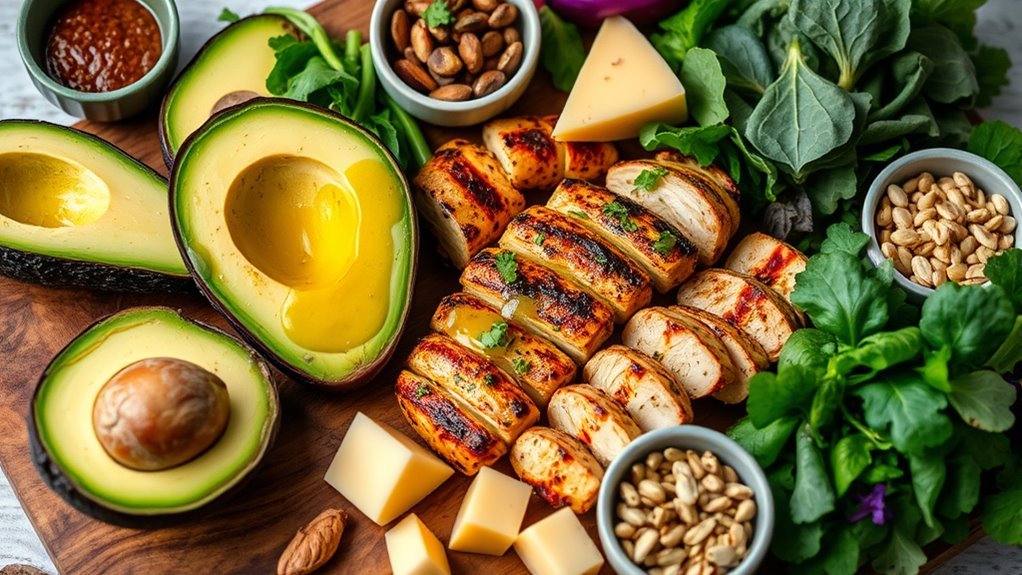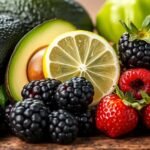On the keto diet, you’ll focus on high-fat, low-carb foods. Incorporate healthy fats like avocados and olive oil, along with low-carb vegetables such as spinach and cauliflower. Choose lean protein sources, including grass-fed meats and fatty fish like salmon. Full-fat dairy products, along with nuts and seeds, provide nutritious snacks. Hydrate primarily with water and opt for low-carb beverages. For sweetness, use keto-friendly sweeteners like stevia and erythritol. Discover more about specific food options and meal strategies.
Understanding the Keto Diet Basics
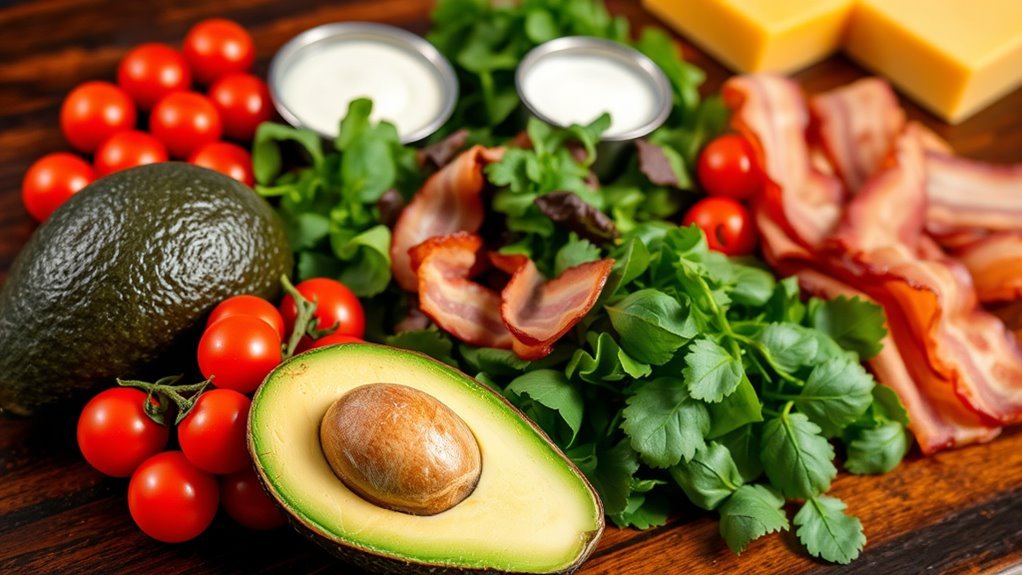
Understanding the Keto Diet Basics begins with recognizing its core principle: considerably reducing carbohydrate intake while increasing fat consumption to shift your body into a state of ketosis. This metabolic state enables your body to burn fat for energy instead of carbs. One common keto diet misconception is that all fats are unhealthy; however, choosing the right kinds of fats is key. Effective keto meal planning involves focusing on high-quality, nutrient-dense foods like avocados, nuts, and seeds. It’s important to balance your meals to maintain essential nutrients while enjoying the freedom this lifestyle offers. By debunking myths and embracing proper meal strategies, you can navigate the keto landscape confidently and achieve your health goals.
Healthy Fats to Incorporate
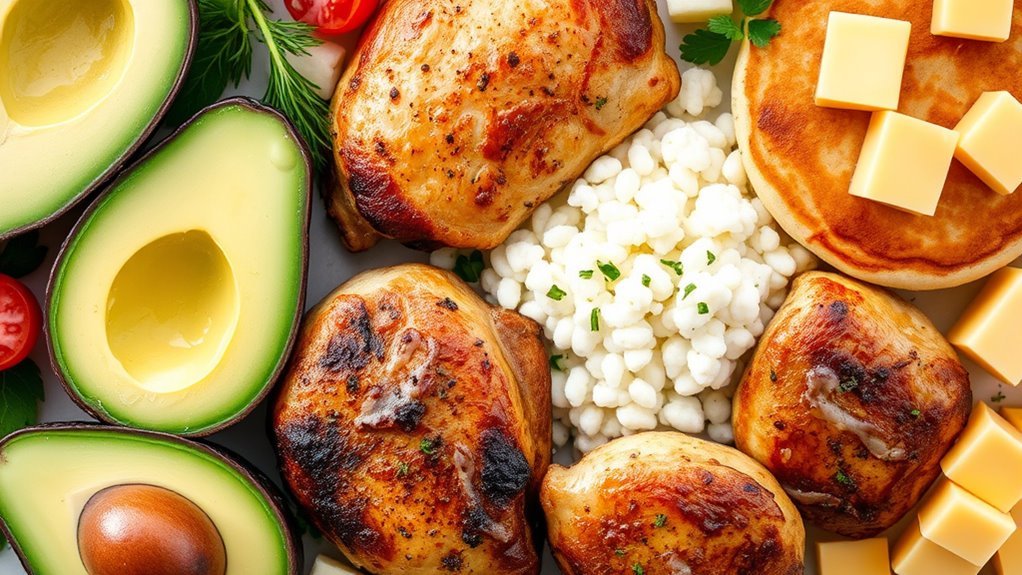
Incorporating healthy fats into your keto diet is essential for achieving and maintaining ketosis while supporting overall health. One fantastic fat source is avocado, known for its numerous benefits. Avocados are rich in monounsaturated fats, which help reduce bad cholesterol levels and promote heart health. Plus, they’re packed with fiber, keeping you satiated longer. Another excellent choice is olive oil, renowned for its anti-inflammatory properties and antioxidants. Drizzling high-quality extra virgin olive oil over your meals can enhance flavor while providing essential fatty acids. By prioritizing these healthy fats, you not only fuel your body effectively but also enjoy the freedom of delicious, satisfying foods that align with your keto lifestyle. Embrace these options for a balanced approach to fat intake.
Low-Carb Vegetables
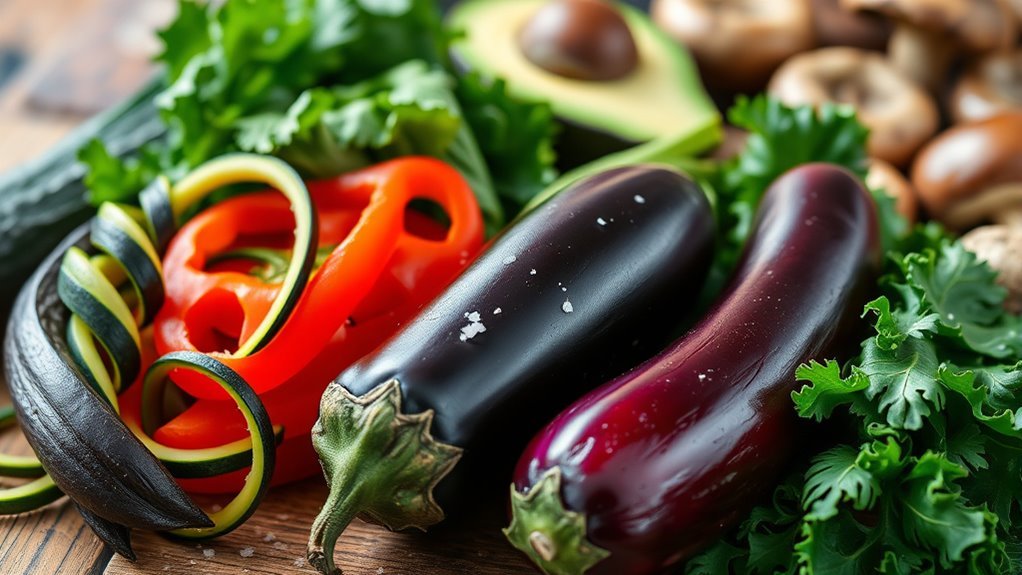
When following a keto diet, incorporating low-carb vegetables is vital for maintaining your carb limits while still getting essential nutrients. Options like spinach, zucchini, and cauliflower not only fit the bill but also offer versatility in your meals. Understanding the best cooking methods for these vegetables can enhance their flavor and nutritional value, making them a tasty addition to your diet.
Best Low-Carb Options
Although it might seem challenging to find flavorful vegetables that fit within a low-carb diet, there are plenty of delicious options that can enhance your meals without sabotaging your macro goals. Leafy greens like spinach, kale, and arugula are excellent choices, offering essential nutrients and minimal carbs. Cruciferous vegetables such as broccoli, cauliflower, and Brussels sprouts are also great low-carb substitutions, perfect for keto meal prepping. Zucchini and bell peppers add color and taste while keeping your carb count low. Don’t forget about asparagus and mushrooms, which are flavorful additions that complement many dishes. By incorporating these veggies, you can enjoy variety and satisfaction while maintaining your keto lifestyle, ensuring your meals remain exciting and nutritious.
Cooking Methods Explained
Understanding the best cooking methods for low-carb vegetables can greatly enhance their flavor and texture, making them more enjoyable in your keto meals. Grilling techniques, for instance, allow you to caramelize the natural sugars in veggies like zucchini and bell peppers, adding a smoky depth. Simply toss them in olive oil, season, and grill until tender.
On the other hand, slow cooking brings out the rich flavors in heartier vegetables like cauliflower and cabbage. By cooking them low and slow, you help retain their nutrients while achieving a satisfying tenderness. This method often allows you to infuse them with herbs and spices, creating a deliciously aromatic dish. Embrace these techniques to elevate your low-carb vegetable game!
Protein Sources for Keto
As you’re exploring the keto diet, it’s vital to identify high-quality protein sources that align with your low-carb goals. Lean meats like chicken, turkey, and beef are excellent choices, providing essential amino acids while keeping your carb intake low. Opt for grass-fed or pasture-raised options for added nutritional benefits. Seafood options, such as salmon, sardines, and shrimp, are not only rich in protein but also offer omega-3 fatty acids, which are beneficial for heart health and inflammation reduction. Incorporating these proteins into your meals can help you maintain muscle mass while adhering to your ketogenic lifestyle. Focus on variety and quality to guarantee your body gets the nutrients it needs while enjoying the freedom of flavorful, satisfying meals.
Dairy Products That Fit
When it comes to the keto diet, high-fat dairy options can be a delicious and satisfying way to meet your fat intake goals. You’ll find that many cheeses are low in carbs, making them perfect for your meal planning. Incorporating items like cream cheese, full-fat yogurt, and hard cheeses can enhance your dishes while keeping you in ketosis.
High-Fat Dairy Options
If you’re following a keto diet, incorporating high-fat dairy options can greatly enhance your meal plans while keeping your carb intake low. Full-fat options like heavy cream and sour cream are excellent choices, providing rich flavors and essential fats. You might also explore cream alternatives like coconut cream, which can add a delightful twist to your recipes. When it comes to butter types, consider using grass-fed butter for its higher omega-3 fatty acid content and better nutrient profile. Ghee is another fantastic option, offering a lactose-free alternative that’s perfect for cooking. These high-fat dairy products not only satisfy your taste buds but also help maintain your energy levels, aligning perfectly with your keto lifestyle. Enjoy the freedom to indulge!
Low-Carb Cheese Choices
While it’s important to limit carb intake on a keto diet, you don’t have to sacrifice the joy of cheese. In fact, certain cheese varieties are perfect for your low-carb lifestyle. Here’s a quick reference table for your favorite cheeses and their carb content:
| Cheese Type | Carbs (per 1 oz) | Great Pairings |
|---|---|---|
| Cheddar | 0.4g | Nuts, avocado |
| Mozzarella | 0.6g | Olives, tomatoes |
| Parmesan | 0.9g | Spinach, meats |
| Cream Cheese | 0.6g | Berries, flaxseeds |
| Gouda | 0.6g | Cured meats, pickles |
These low-carb cheese choices can enhance your meals and snacks, allowing you to enjoy delicious cheese pairings while staying on track with your keto goals.
Nuts and Seeds to Enjoy
Nuts and seeds are not only delicious but also packed with essential nutrients that make them a perfect addition to your keto diet. Incorporating a variety of nuts, like almonds, walnuts, and pecans, offers significant nut benefits, including healthy fats, protein, and fiber, which help keep you satiated. Meanwhile, different seed varieties, such as chia, flax, and pumpkin seeds, provide omega-3 fatty acids and crucial minerals like magnesium and zinc. These nutrient-dense options can enhance your meals or serve as satisfying snacks. By choosing raw or dry-roasted versions, you’ll avoid unnecessary additives. Embrace the freedom of experimenting with these versatile foods while enjoying their numerous health benefits on your keto journey!
Keto-Friendly Snacks
When you’re on a keto diet, finding snacks that align with your low-carb lifestyle can be a challenge, but it doesn’t have to be. You can explore various keto snack ideas that satisfy cravings without derailing your progress. Consider cheese crisps or pepperoni chips for a crunchy treat. Nuts and seeds, while previously discussed, also make excellent quick keto treats. For something sweet, try dark chocolate with a high cocoa content or coconut chips. If you’re looking for convenience, pre-packaged keto snacks like beef jerky or pork rinds can be lifesavers. Always check labels to verify they fit your macros. Embrace the freedom of delicious, satisfying snacks that keep you in ketosis while enjoying your journey!
Beverages for the Keto Diet
Finding the right beverages can be just as important as selecting the right snacks on your keto journey. For hydration, water is your best friend, but you might want to explore keto smoothies. These nutrient-packed drinks can be made with low-carb ingredients like spinach, avocado, and unsweetened almond milk, offering a tasty way to fuel your body. Additionally, herbal teas are excellent choices, providing various flavors without added sugars or carbs. Look for caffeine-free options like chamomile or peppermint to enjoy throughout the day. Just remember to avoid sugary drinks and high-carb beverages that could interfere with your ketosis. By choosing wisely, you’ll support your keto lifestyle and enjoy invigorating, satisfying drinks.
Sweeteners Suitable for Keto
Although sugar is often a staple in many diets, you can still satisfy your sweet tooth on a keto diet by using suitable sweeteners. Opt for sugar substitutes like erythritol, stevia, and monk fruit, which have minimal to no impact on your blood sugar levels. These natural sweeteners provide the sweetness you crave without derailing your ketosis. Erythritol, for instance, has about 70% of the sweetness of sugar but only 0.24 calories per gram. Stevia and monk fruit are also popular choices, being derived from plants and containing no carbs. Remember to check labels, as some sweeteners may contain hidden sugars. Embrace these alternatives, and you can enjoy your favorite treats while staying true to your keto lifestyle.
